CMS experiment prepares for Run 3
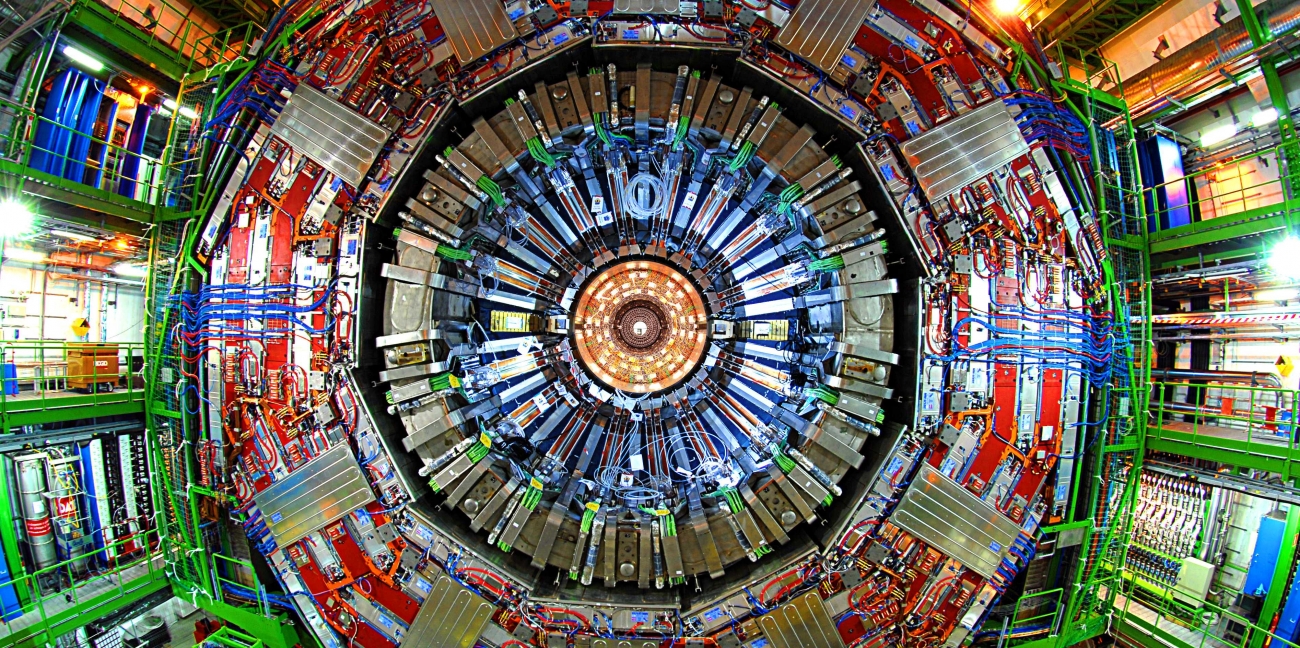
The CMS experiment is one of the four large experiments at the LHC and a detailed description of the detector's inner and outer layers can be found here. The detector successfully operated with LHC collisions since 2010 leading to the Higgs boson discovery in 2012 by the CMS and ATLAS collaborations. In the past ten years, the CMS Collaboration has published more than one thousand scientific papers on a highly diverse range of particle physics topics.
After the successful Run 1 operations of the LHC, with a centre of mass energy of 7-8 TeV, a second data-taking period at 13 TeV energy followed in 2015-2018 accumulating about 140 fb-1 of integrated luminosity, Run 2. A third data-taking period, Run 3, is foreseen to start in 2022. Multiple upgrades of the CMS detector happened during and after Run 2 to better handle the high luminosity conditions of the last years of Run 2 and Run 3.
Run 2 and preparation for Run 3
The analysis of data taken between 2015 and 2018 has already lead to several hundred publications ranging from precision measurements of the Standard Model (SM) to searches for new physics. While many analyses have been concluded, numerous are still ongoing and will be published by the collaboration in the next few years. The Run 2 data have already provided few clear answers to some open questions in High Energy Physics. These answers will serve as a guide to establish the future physics program of CMS. Run 3 will start in 2022 and is expected to double the integrated luminosity of Run 2. The centre of mass energy for pp collisions could increase up to 14 TeV but this will be finally decided after the LHC magnet training in 2021.
In order to reach the highest luminosity in the 3 years of Run 3, a high pile-up from interactions in a single bunch crossing is expected. The maximum instantaneous pile-up in Run 3 will be similar to that of the 2018 data taking period but the average larger. The machine plans to maintain the maximum instantaneous luminosity for several hours at the beginning of each fill. Such challenging pile-up warranted the recent CMS experiment upgrade of key components to resolve the multiple interactions and efficiently analyze the data. For example, the CMS pixel tracking detector, after undergoing an important upgrade between 2016 and 2017, has been further upgraded in its innermost layer in order to handle the high rates of Run3; the hadronic calorimeter (HCAL) has been improved with enhanced readout granularity along the shower depth; the first stations GE1/1 of the Phase 2 upgrade detectors for the High Luminosity phase of the LHC, the Gas Electron Multiplier (GEM) detectors. have been installed; and the High-Level Trigger (HLT) system will be equipped with GPUs in order to accelerate some online reconstruction tasks.
The greater integrated luminosity will allow the CMS Collaboration to shed more light on rare phenomena. In particular, with Run 2, multiple SM predicted processes reached or nearly missed the first sensitivity: multiple first pieces of evidence and observations were reported in the past few years, and more will come with Run 3, where conventionally the evidence is claimed when the signal has a significance of 3 standard deviations and observation when the significance is 5 standard deviations.
In addition to doubling the integrated luminosity, Run 3 will allow the CMS Collaboration to address unexplored phase space in searches for new phenomena, thanks to improved triggers. Improvements are expected in several areas: firstly CMS is planning to deploy more efficient Level 1 triggers for long-lived particles; secondly, the collaboration is investigating how to boost the non-conventional trigger program further: scouting and B-parking, more relevant for searches and B physics respectively and discussed in the following.
Finally, CMS will also have a rich Heavy Ion program with different collision systems including PbPb, pPb as in Run 2 but also OO and pO which were never collided before at the LHC.
Higgs boson physics
The discovery of the Higgs boson in July 2012 was dominated by the analyses targeting its di-boson decay which, at the 125 GeV mass value where the new particle was observed, give the largest sensitivity. In the following years, additional decay and production modes have been studied in detail, and precision measurements of the mass and other properties have been performed. The observation threshold was passed for all main decay modes, including those to fermions such as Η → τ τ and Η → bb. A precise measurement of the mass was obtained both in the four-lepton final state and in the diphoton channel. Multiple production modes were also observed, including the ttH production mechanism that gives direct access to the Higgs coupling to top quarks. More recently CMS started to shed light on the couplings to second-generation fermions, reporting the first evidence of the Higgs boson decay to a pair of muons.
The Higgs boson has been precisely characterized, as shown in Figure 1, during Run 2 and confirmed to be so far compatible with the particle predicted in the SM.
While still far from SM sensitivity, the Run 2 Higgs physics program also included searches for double Higgs production (HH) that would allow to study the Higgs boson self-interactions directly and give direct access to the parameters describing the Higgs potential.

Figure 1. (Left) Summary of measured coupling modifiers of the Higgs boson with fermions and vector bosons as a function of the particle masses which shows that they are consistent with being proportional to the mass as predicted by the Standard Model. (Right) Signal strength modifiers for the production (horizontal axis) times decay mode (vertical axis) in all measured channels.
The process of progressive shifting from the measurements of total cross sections to differential measurements that started in Run 2will continue through Run 3. Similarly, measurements in the so-called simplified template cross section (STXS) framework which divides each channel into sub-channels based on topological and kinematical properties will increase the granularity with the additional integrated luminosity. The sensitivity for the detection of rare processes will increase and in some cases could pass the evidence or observation thresholds, assuming Standard Model cross sections, during Run 3.
Standard Model and Top physics
The large LHC centre of mass energy allows the study of production and decays of single and multiple heavy objects such as the W and Z bosons or the top quark. During Run 2, the production of double vector bosons has been measured as well as the electroweak production of vector bosons in association with two jets, that includes Vector Boson Fusion (VBF) and Vector Boson Scattering (VBS) processes, and where the two final state jets exhibit a large rapidity separation and suppressed additional hadronic activity between the two jets, besides the decay products of the vector boson(s). The LHC Run 2 data allowed to study multiple production processes for top quarks (single top, ttbar and associated production with vector bosons) and extend the study of the top quark properties.
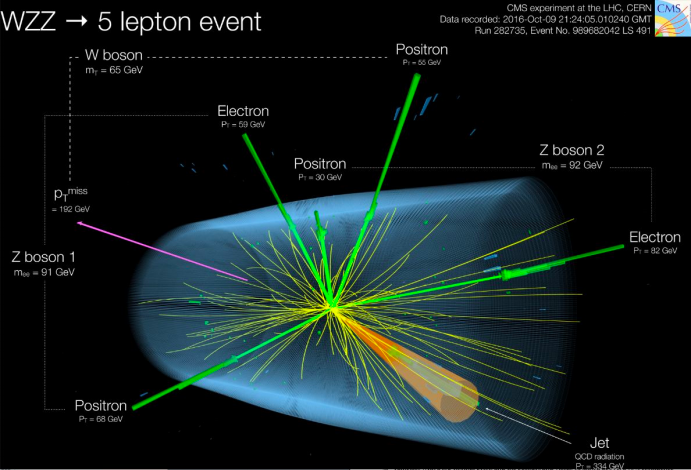
Figure 2. Event display of a candidate WZZ event in the five lepton final state. Tracks from the positrons and electrons in the event are represented by green lines. The green towers indicate the electromagnetic calorimeter energy deposits from the positrons or electrons. In this event, there are two pairs of oppositely charged electrons with their invariant masses consistent with Z mass. In addition, there is an extra electron in the event. The neutrino in the event is represented by the pink arrow (pTmiss). The transverse mass of the fifth electron and the pTmiss is 65 GeV, perfectly consistent with the value expected for a W boson.
Recently, CMS reported the first observation of the triple vector boson production, the sum of WWW, WWZ, WZZ, and ZZZ, with a significance of 5.7 standard deviations. Figure 2 shows a spectacular event, candidate for the WZZ process producing five charged leptons in the final state.
As for the Higgs boson measurements, in Run 3, thanks to increased integrated luminosity more processes will be measured differentially, and a larger sensitivity for deviations from the SM predictions due to new physics will be reached. Interpretations in the framework of effective field theories (EFT) will continue, and combined interpretations of multiple signals are expected to become more and more common. The production of multiple vector bosons, especially through electroweak processes, will allow the study of the trilinear and quadrilinear couplings with increased sensitivity, which could potentially give indications to physics beyond the SM. If the LHC centre of mass energy will increase, new production cross sections at a different centre of mass energy will also be measured.
B-physics
In Run 2 CMS continued the extensive B physics program started in Run 1. Thanks to the pixel and strip tracker which precisely measures the momenta and secondary vertices of charged tracks, and to the muon detector, which is able to efficiently trigger events with muons with momenta as low as a few GeV, it is possible to carry out a broad spectrum of physics analyses addressing heavy flavour particles. One example is the measurement of the B0s → μμ decay which has a tiny branching fraction and is very sensitive to the presence of new particles which could increase it substantially. Using the Run 1 data and adding the 2016 data at 13 TeV, CMS largely improved the Run 1 results and observed the process B0s→μ+μ− with a significance of 5.6 standard deviations. The spectrum of the μ+μ− mass from the combination of the most sensitive categories is shown in Figure 3, and the branching fraction is measured to be B0s → μ+μ− = [2.9 +0.7−0.6 (exp) ± 0.2 (frag) ]×10−9 , where the first uncertainty represents the combination of the experimental statistical and systematic contributions, and the second is due to the uncertainty in the ratio of the B0s and the B+ fragmentation functions.
Furthermore, CMS discovered several new states. Signals consistent with the B±c (2S) and B*±c (2S) states, and very recently the observation of a new excited beauty strange hadron with mass 6100 MeV and decaying to Ξbπ+ π− were reported. A new decay of the exotic charmonium state X(3872) was also observed for the first time.
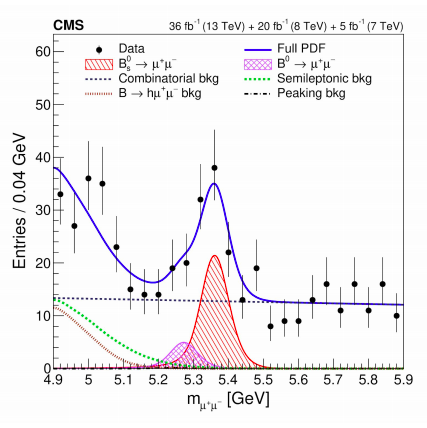
Figure 3. Dimuon invariant mass distributions with the sum of the fit projections (the fit is carried out in 2D: mass versus decay proper time) overlaid. The plot shows the combined results from most sensitive categories. The total fit is shown by the solid line and the different background components by the dashed and dotted lines. The signal components are shown by the hatched distributions.
In 2018, the last year of Run 2, CMS collected 12 billion events in the so-called B-parking dataset, which exploits dedicated triggers on single displaced muons. The trigger selects a sample enriched in events with a B hadron decaying leptonically which recoils against another B-hadron for which no selection is applied (unbiased). Given the purity of about 70-80%, the total number of unbiased B-hadrons is estimated to be almost 10 billion. This dataset has been reconstructed during the shutdown and is currently being analyzed with the first results expected to be made public at the Moriond 2021 conferences. During Run 3, CMS plans to continue to collect similar data and expects to more than double the existing dataset with the 2022 data taking alone.
Searches
Direct searches for new particles constitute a large part of the CMS physics program. No indications of significant discrepancies with respect to the standard model have yet been found (in Figure 4 a classic example of the search for a Z’ boson is shown). However, the negative results in searches for all possible signatures increase our knowledge of the viable models which could explain some of the open questions in physics, such as the origin of the dark matter. The constraints obtained until now also guide our future searches, pointing them towards signatures predicted by promising new physics models that are not yet excluded.
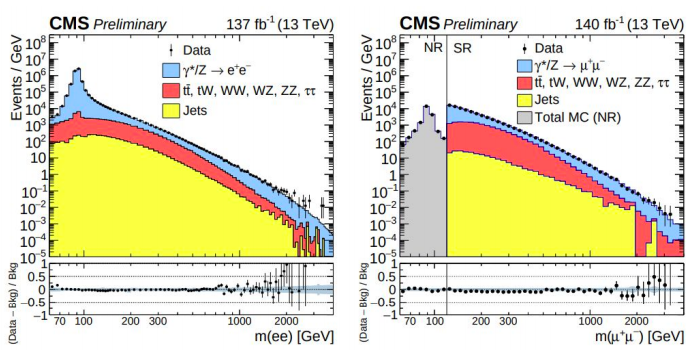
Figure 4. The invariant mass of leptons (electrons on the left, muons on the right) is explored up to above 2 TeV looking for a narrow peaking structure. Such a striking signature is predicted by multiple models extending the Standard Model and would be a clear sign of new physics. So far no such feature is observed and the quest will continue during Run 3.
Run 3 offers very interesting prospects for the CMS searches programme. As mentioned in the introduction, we expect to boost our sensitivity in the search for long-lived particles, thanks to the implementation and deployment of new triggers. Long-lived particles are predicted by several models and could appear in a multitude of different signatures in the detector. Furthermore, the CMS scouting program, based on the idea of carrying out the analysis only using the information reconstructed in real time in the HLT farm, will be expanded in scope. In view of HL-LHC, already in Run 3, CMS is planning to start using a heterogeneous architecture for the online reconstruction, comprising CPUs and GPUs. Part of the HLT reconstruction, namely pixel, ECAL, and HCAL local reconstruction, and pixel-based tracking have been already ported and are able to run on GPUs for a total of 25% of CPU time offload to GPU. Porting of more code, including particle flow algorithms, is envisioned in the near future GPU reconstruction is more efficient and will allow track reconstruction on a larger fraction of the events triggered at Level 1, increasing the sensitivity of the scouting program to lower masses.
Heavy-Ion physics
The CMS Heavy Ion program has been very successful in Run 2, and many physics results have been published based on pPb, PbPb, and XeXe collisions. The main purpose of these studies is to shed light on the properties of the quark-gluon plasma (QGP) that is the hot and dense matter produced in Heavy Ion collision and consisting of a system of deconfined quarks and gluons. The comparison of the properties of the elementary interactions between proton-proton, proton-nucleus, and nucleus-nucleus allows probing the interactions of particles with QGP. A highlight of the Run 2 analyses is the first evidence (with 4 sigma significance) of the top-antitop quark production in lead-lead collisions which follows the first observation of the same process in proton-lead collisions, still by CMS in 2018. An event display of a top-antitop candidate in PbPb collisions is shown in Figure 5.
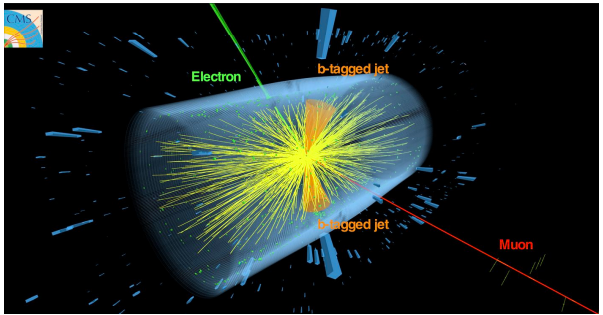
Figure 5 CMS candidate event of production of a top quark-antiquark pair decaying into an electron, a muon and two b jets originating from bottom (b) quarks. (Image: CERN).
Run 3 is expected to bring even a larger improvement in terms of integrated luminosity for PbPb collisions than for standard pp collisions. In fact with the planned three years of LHC heavy ion runs, we expect to collect 5-10 nb-1 of integrated luminosity to be added to the 2.5 nb-1 of Run 2, reducing the statistical uncertainties of the measurements by approximately a factor two. The increased precision will allow us to better understand the properties of the QGP produced in high energy heavy ion collisions.
Figure 6 shows the example of the expected improvements in the measurement of long-range correlations of the Upsilon (1S) by means of the second-order Fourier component of the azimuthal anisotropy v2, derived from two-particle correlations.
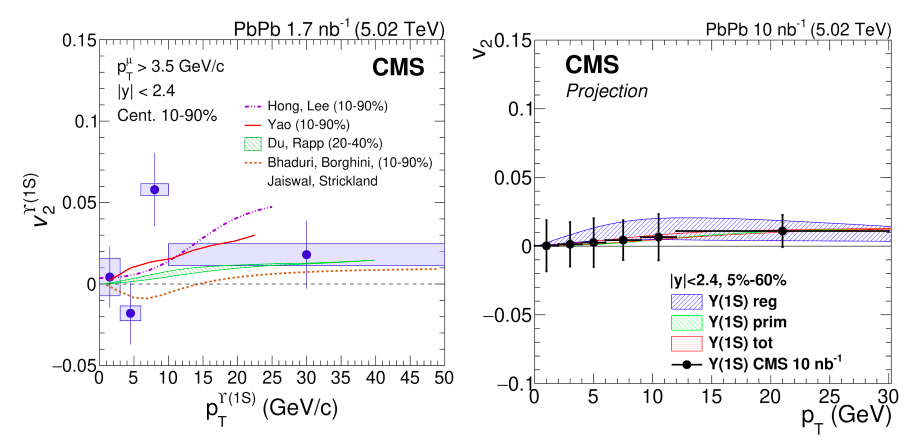
Figure 6. (Left) v2 of Υ(1S) mesons as a function of pT in the 10-90% centrality range and in the rapidity range of |y|< 2.4.compared with several model calculations. The vertical bars indicate statistical uncertainties, and the rectangular boxes show the total systematic uncertainties. (Right) Projections for v2 of Υ(1S) mesons, assuming 10 nb−1. The projected data points are overlaid with the total theoretical prediction in red.
Outlook
After the success of Run 2, CMS eagerly waits for Run 3 planned to start in 2022. The expected increase in integrated luminosity, of more than a factor 2 for pp collisions and of a factor 3-5 for PbPb collisions, together with a possible increase in centre of mass energy for pp collisions will allow to substantially improve all the results obtained until now and to largely increase the sensitivity to new physics. Further improvements in searches for unknown phenomena are also expected to also from improved triggers and improved online reconstruction. The latter may also profit from the usage of GPUs in the high-level trigger, considered to be already deployed in production already in 2022.
Read more
Follow the links below and stay updated with the latest results from the CMS experiment.
CMS Physics results: http://cms-results.web.cern.ch/cms-results/public-results/publications/
CMS Physics briefings: https://cms.cern/tags/physics-briefing
